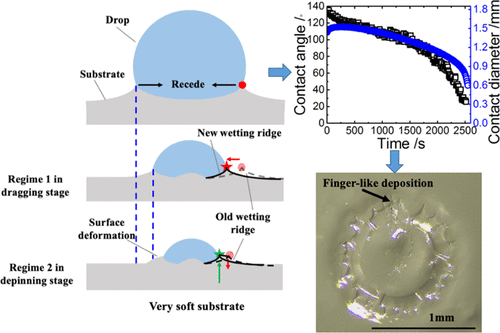Our official English website, www.x-mol.net, welcomes your feedback! (Note: you will need to create a separate account there.)
On the Effect of Substrate Viscoelasticity on the Evaporation Kinetics and Deposition Patterns of Nanosuspension Drops.
Langmuir ( IF 3.9 ) Pub Date : 2020-01-03 , DOI: 10.1021/acs.langmuir.9b02965 Yuhong Chen 1 , Alexandros Askounis 2 , Vasileios Koutsos 3 , Prashant Valluri 1 , Yasuyuki Takata , Stephen K Wilson 4 , Khellil Sefiane 1
Langmuir ( IF 3.9 ) Pub Date : 2020-01-03 , DOI: 10.1021/acs.langmuir.9b02965 Yuhong Chen 1 , Alexandros Askounis 2 , Vasileios Koutsos 3 , Prashant Valluri 1 , Yasuyuki Takata , Stephen K Wilson 4 , Khellil Sefiane 1
Affiliation

|
This study investigates the evaporation of sessile pure water and nanosuspension drops on viscoelastic polydimethylsiloxane (PDMS) films. We varied the viscoelasticity of the PDMS films by controlling the curing ratio and categorized them into three types: stiff (10:1, 20:1, 40:1), soft (60:1, 80:1), and very soft (100:1, 120:1, 140:1, 160:1). On stiff surfaces, pure water drops initially evaporate in a constant contact radius (CCR) mode, followed by a constant contact angle mode, and finally in a mixed mode of evaporation. Nanosuspension drops follow the same trend as water drops but with a difference toward the end of their lifetimes, when a short second CCR mode is observed. Complete evaporation of nanosuspension drops on stiff substrates leads to particle deposition patterns similar to a coffee ring with cracks and deposition tails. On soft surfaces, the initial spreading is followed by a pseudo-CCR mode. Complete evaporation of nanosuspension drops on soft substrates leads to deposits in the form of a uniform ring with a sharp ox-horn profile. Unexpectedly, the initial spreading is followed by a mixed mode on very soft substrates, on which wetting ridges (WRs) pulled up by the vertical component of surface tension are clearly observed in the vicinity of the contact line (CL). As the evaporation proceeds, the decreasing contact angle breaks the force balance in the horizontal direction at the CL and gives rise to a net horizontal force, which causes the CL to recede, transferring the horizontal force to the WR. Because of the viscoelastic nature of the very soft substrate, this horizontal force acting on the WR cannot be completely countered by the bulk of the substrate underneath. As a result, the WR moves horizontally in a viscous-flow way, which also enables the CL to be continuously anchored to the ridge and to recede relative to the bulk of the substrate. Consequently, a mixed mode of evaporation occurs. Complete evaporation of nanosuspension drops on very soft substrates leads to finger-like deposits.
中文翻译:

关于基质粘弹性对纳米悬浮液滴蒸发动力学和沉积模式的影响。
这项研究调查了粘弹性聚二甲基硅氧烷(PDMS)薄膜上无柄纯水的蒸发和纳米悬浮液滴。我们通过控制固化率来改变PDMS膜的粘弹性并将其分为三种类型:刚性(10:1、20:1、40:1),柔软(60:1、80:1)和非常柔软( 100:1、120:1、140:1、160:1)。在坚硬的表面上,纯净的水滴最初以恒定的接触半径(CCR)模式蒸发,然后以恒定的接触角模式蒸发,最后以混合蒸发模式蒸发。当观察到短暂的第二CCR模式时,纳米悬浮液滴的趋势与水滴的趋势相同,但寿命将有所不同。纳米悬浮液滴在硬质基材上的完全蒸发会导致颗粒沉积,类似于具有裂纹和沉积尾部的咖啡环。在软表面上,初始扩展之后是伪CCR模式。纳米悬浮液滴在软质基材上的完全蒸发会导致形成具有清晰牛角轮廓的均匀环形式的沉积物。出乎意料的是,在非常柔软的基板上,最初的扩散之后是混合模式,在该基板上,在接触线(CL)附近清晰地观察到由表面张力的垂直分量所拉起的润湿脊(WR)。随着蒸发的进行,减小的接触角会破坏CL处水平方向上的力平衡,并产生净水平力,这会导致CL消退,从而将水平力传递给WR。由于非常柔软的基材具有粘弹性,作用在WR上的水平力无法完全被下面的大部分基板所抵消。结果,WR以粘性流的方式水平移动,这也使CL能够连续锚固到脊上,并相对于大部分基板后退。因此,发生蒸发的混合模式。纳米悬浮液滴在非常柔软的基材上的完全蒸发会导致手指状的沉积物。
更新日期:2020-01-04
中文翻译:

关于基质粘弹性对纳米悬浮液滴蒸发动力学和沉积模式的影响。
这项研究调查了粘弹性聚二甲基硅氧烷(PDMS)薄膜上无柄纯水的蒸发和纳米悬浮液滴。我们通过控制固化率来改变PDMS膜的粘弹性并将其分为三种类型:刚性(10:1、20:1、40:1),柔软(60:1、80:1)和非常柔软( 100:1、120:1、140:1、160:1)。在坚硬的表面上,纯净的水滴最初以恒定的接触半径(CCR)模式蒸发,然后以恒定的接触角模式蒸发,最后以混合蒸发模式蒸发。当观察到短暂的第二CCR模式时,纳米悬浮液滴的趋势与水滴的趋势相同,但寿命将有所不同。纳米悬浮液滴在硬质基材上的完全蒸发会导致颗粒沉积,类似于具有裂纹和沉积尾部的咖啡环。在软表面上,初始扩展之后是伪CCR模式。纳米悬浮液滴在软质基材上的完全蒸发会导致形成具有清晰牛角轮廓的均匀环形式的沉积物。出乎意料的是,在非常柔软的基板上,最初的扩散之后是混合模式,在该基板上,在接触线(CL)附近清晰地观察到由表面张力的垂直分量所拉起的润湿脊(WR)。随着蒸发的进行,减小的接触角会破坏CL处水平方向上的力平衡,并产生净水平力,这会导致CL消退,从而将水平力传递给WR。由于非常柔软的基材具有粘弹性,作用在WR上的水平力无法完全被下面的大部分基板所抵消。结果,WR以粘性流的方式水平移动,这也使CL能够连续锚固到脊上,并相对于大部分基板后退。因此,发生蒸发的混合模式。纳米悬浮液滴在非常柔软的基材上的完全蒸发会导致手指状的沉积物。



























 京公网安备 11010802027423号
京公网安备 11010802027423号